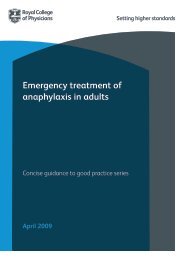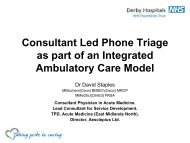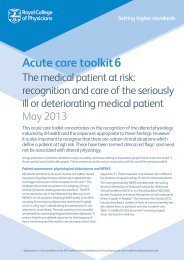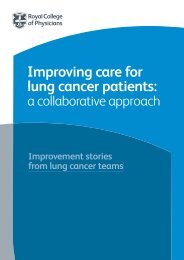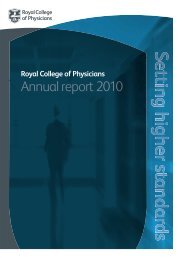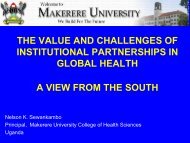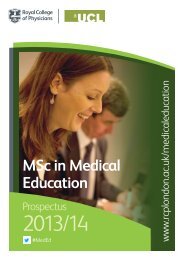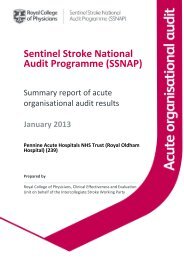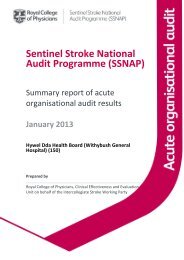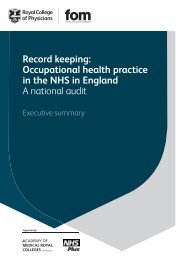Consultant physicians working with patients 5th edition - FSEM
Consultant physicians working with patients 5th edition - FSEM
Consultant physicians working with patients 5th edition - FSEM
You also want an ePaper? Increase the reach of your titles
YUMPU automatically turns print PDFs into web optimized ePapers that Google loves.
<strong>Consultant</strong> <strong>physicians</strong> <strong>working</strong> <strong>with</strong> <strong>patients</strong><br />
Allergies in children<br />
Forty per cent of children have allergies. Owing to a<br />
shortage of paediatric allergists, children are often seen<br />
by adult allergists.<br />
Main disease patterns<br />
Wide-ranging nature<br />
Allergic disease is wide ranging (as listed above).<br />
Allergists also deal <strong>with</strong> non-IgE-mediated disorders,<br />
including rhinitis, angioedema and anaphylaxis.<br />
Complexity<br />
Multiple disorders and multiple allergies are common<br />
in an individual, eg asthma, rhinitis, eczema, food<br />
allergy and anaphylaxis coexist. There are cross-reacting<br />
allergens.<br />
New allergies<br />
New kinds of allergies are emerging, eg foods, drugs and<br />
diagnostics.<br />
Progression<br />
In children, allergies develop progressively. Much of this<br />
persists to adulthood.<br />
Severity<br />
A proportion of <strong>patients</strong> has severe or life-threatening<br />
disease or disease impairing schooling or ability to work<br />
(eg anaphylaxis, airway oedema or multi-system<br />
allergy).<br />
2 Organisation of the service and patterns<br />
of referral<br />
A typical service<br />
There is a specialist definition for allergy (Specialised<br />
services national definitions set, definition no 17). 6 The<br />
purpose is to identify the activity that should be<br />
regarded as specialised and hence <strong>with</strong>in the remit of<br />
PCT collaborative commissioning. However, there is<br />
lack of recognition by commissioners of the need for<br />
allergy commissioning. This occurs around the<br />
established specialist allergy centres but is lacking in<br />
many parts of the country. Allergy is a specialty<br />
recognised for specialist commissioning by the DH in<br />
England.<br />
Specialist services<br />
These provide high-throughput, comprehensive,<br />
full-time services led by allergists <strong>with</strong> the expertise to<br />
deal <strong>with</strong> a range of allergic diseases. These services<br />
28<br />
typically offer: one-stop diagnosis and management;<br />
complex investigation requiring day-case service, eg for<br />
drug or food allergy; immunotherapy; and anti-IgE<br />
therapy. There are only a small number of these<br />
services, but each sees large numbers and more complex<br />
<strong>patients</strong> (eg ∼5,000 pa).<br />
Subspecialty services<br />
Other clinics are part time and provided by consultants<br />
in other specialties, most of whom offer a limited<br />
spectrum of diagnostic and treatment facilities. 5<br />
There is a geographical inequality and national shortage<br />
of doctors <strong>with</strong> allergy expertise. GPs dealing <strong>with</strong> the<br />
brunt of allergic disease have limited training and access<br />
to specialist advice.<br />
Current services and proposals for allergy care are<br />
outlined in the RCP report 3 and the British Society for<br />
Allergy & Clinical Immunology (BSACI) and National<br />
Allergy Strategy Group (NASG) submissions to the<br />
DH. 5,7,8 The RCP proposed the following:<br />
� Tier 1 – simpler allergic diseases managed in<br />
primary care or by self care (allergy diagnosis often<br />
not required)<br />
� Tier 2a – consultant allergists in teaching hospitals<br />
and district general hospitals to provide secondary<br />
care<br />
� Tier 2b – other specialists <strong>with</strong> an interest in allergy<br />
(immunologists; dermatologists; respiratory<br />
<strong>physicians</strong>; ear, nose and throat (ENT) specialists;<br />
paediatricians) to contribute to secondary care<br />
� Tier 3 – regional allergy centres to manage<br />
specialised tertiary problems and provide local<br />
secondary care.<br />
This model has been developed subsequently in papers<br />
from BSACI identifying the burden of disease and<br />
referral pathways. 7,8<br />
Sources of referral from primary, secondary<br />
and tertiary levels<br />
Referral is mainly direct to a specialist centre from a<br />
patient’s GP (>80%) but from a wide (often regional)<br />
catchment. Patients are also referred from other<br />
services, eg respiratory, dermatology and anaesthetics.<br />
Locality-based and/or regional services<br />
Most major specialist services provide a regional and<br />
local service because of few providers in each region.<br />
C○ Royal College of Physicians 2011



